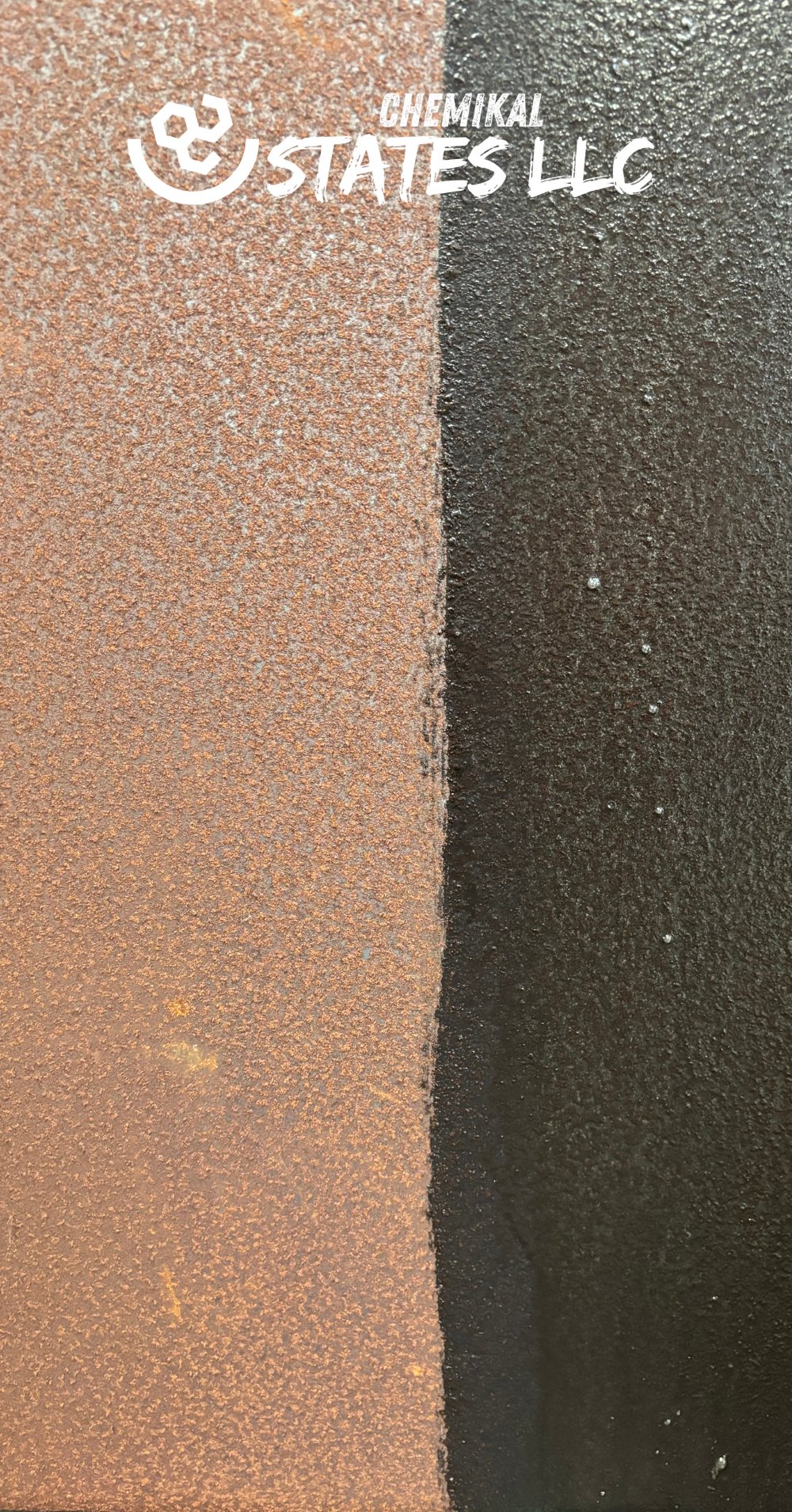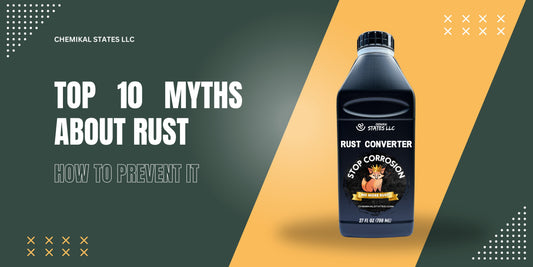
Rust Converters Comparison: Why Chemikal States Rust Converter Stands Out
Share
Choosing the right rust converter is crucial for the effectiveness of restoration and long-term protection of metal surfaces. Various products on the market offer corrosion protection, but one stands out – Chemikal States Rust Converter. Let’s examine why this product might be the best choice for your needs.

1. Unique Ability to Degrease Surfaces
One of the most important features that set Chemikal States Rust Converter apart is its ability to degrease surfaces. This converter not only effectively transforms rust into a stable protective layer but also eliminates the need for additional cleaning agents to clean the metal before application. This simplifies the application process and enhances the adhesion and effectiveness of the anti-corrosion protection.
2. Safety of Use
User safety is another key factor to consider. Chemikal States Rust Converter is formulated with user safety in mind. Unlike many other rust converters that may contain harsh chemicals, Chemikal States is less harmful and safe to use, which is particularly important when applying in enclosed or poorly ventilated spaces.
3. Effectiveness in Transforming Rust
The effectiveness of Chemikal States in transforming rust into a durable, protective layer is undeniable. The product efficiently penetrates rust, neutralizes it, and converts it into a passive form, preventing further corrosion. This ensures that metal surfaces are protected for longer, which is especially crucial in harsh environmental conditions and areas exposed to intense external factors.
4. Ease of Application
Thanks to its degreasing properties, Chemikal States Rust Converter is extremely easy to apply. It does not require the use of many tools or preparations – just apply the product directly onto the corroded surface, saving time and money.
5. Costs and Cost-Effectiveness
Although the price of Chemikal States may be slightly higher compared to other rust converters, its cost-effectiveness comes from its higher efficiency and long-lasting protection, which reduces the need for frequent reapplication. Additionally, savings from not needing to use degreasers or other cleaning preparations before applying the converter make Chemikal States an even more economical choice.
Conclusion
Chemikal States Rust Converter not only offers high effectiveness in combating corrosion but also unprecedented convenience due to its ability to degrease surfaces and safety of use. If you are looking for a product that will save you time, money, and increase the efficiency of protecting your metal surfaces, Chemikal States Rust Converter is an option definitely worth considering. See for yourself how easy you can extend the lifespan of your metal items by choosing this advanced rust converter!
FAQ: Chemikal States Rust Converter
1. What is Chemikal States Rust Converter?
- Chemikal States Rust Converter is a specialized product that transforms rust into a stable, protective coating, effectively stopping the corrosion process while also degreasing the metal surface in preparation for further treatments.
2. How does Chemikal States Rust Converter work?
- The product works by chemically reacting with the rust (iron oxide) to form a black ferric phosphate layer. This reaction not only neutralizes the rust but also creates a protective barrier against further oxidation.
3. Is Chemikal States Rust Converter safe to use?
- Yes, Chemikal States Rust Converter is formulated to be safer than many other rust treatment products on the market. It contains less harmful chemicals, making it a safer choice for use in enclosed or poorly ventilated areas. However, wearing gloves and protective eyewear is still recommended during application.
4. Can Chemikal States Rust Converter be used on any rusted metal?
- Chemikal States Rust Converter is effective on most rusted ferrous metals, including iron and steel. It is not suitable for non-ferrous metals such as aluminum or copper.
5. How do you apply Chemikal States Rust Converter?
- To apply, ensure the surface is free from loose rust, dirt, and grease. Apply directly onto the rusted area with a brush, roller, or spray. Allow sufficient time for the converter to react and dry.
6. Does the treated surface need to be primed or painted afterward?
- While Chemikal States Rust Converter provides a protective layer, priming and painting the treated surface are recommended for maximum protection and durability, especially in harsh environments.
7. How long does it take for Chemikal States Rust Converter to dry?
- Drying times can vary based on environmental conditions but generally range from 3 to 6 hours for touch dry and up to 24 hours for complete curing.
8. Can I use Chemikal States Rust Converter inside closed profiles or hard-to-reach areas?
- Yes, Chemikal States Rust Converter can be applied in closed profiles and hard-to-reach areas. Special spray probes or equipment may be used to ensure even coverage within these areas.
9. What are the storage conditions for Chemikal States Rust Converter?
- Store in a cool, dry place away from direct sunlight and extreme temperatures. Ensure the lid is tightly closed to prevent drying out.
10. Where can I purchase Chemikal States Rust Converter? - Chemikal States Rust Converter is available at automotive stores, hardware stores, and online. Check local availability or order online for convenience.
11. What makes Chemikal States Rust Converter better than other products? - Its unique ability to not only convert rust but also degrease the metal surface sets it apart from other rust converters. This dual action saves time and enhances the effectiveness of subsequent protective treatments.
Surprising Tips for Using Chemikal States Rust Converter
When it comes to combating rust, most of us stick to the straightforward methods we know. However, here are some surprising tips that can enhance your experience with Chemikal States Rust Converter and make your rust treatment process even more effective:
-
Pre-Application Etching
- Before applying Chemikal States Rust Converter, consider lightly etching the metal surface with a diluted acid solution, like vinegar. This can create a rougher surface that enhances the chemical bonding of the converter, leading to a more durable protective layer.
-
Use with Thermal Tools
- After applying the rust converter, use a heat gun or a hair dryer to gently warm the treated area. This can accelerate the chemical reaction and drying process, especially in cooler or more humid environments.
-
Mix with Paint
- Although it's generally recommended to apply paint after the rust converter has fully cured, in some DIY scenarios, adding a small amount of rust converter directly into oil-based paint can enhance rust prevention properties of the paint itself. Always test this on a small area first to ensure compatibility.
-
Apply Under Direct Sunlight
- If possible, apply Chemikal States Rust Converter on a sunny day. The UV rays and warmth from the sun can improve the effectiveness of the conversion process, reducing drying time and enhancing the formation of the protective layer.
-
Use as a Spot Treatment in Gardening Tools
- Garden tools often get rusty. You can use Chemikal States Rust Converter as a spot treatment on these tools. Not only does it stop the rust, but it can also create a barrier that prevents plant diseases from spreading via rust-infected tools.
-
Create Art with Rust Patterns
- For artists or DIY enthusiasts, apply Chemikal States Rust Converter selectively on metal art pieces to create controlled rust patterns. The converter stops the rusting process, allowing you to maintain the desired aesthetic without further degradation.
-
Emergency Leak Sealant
- While not a permanent fix, in emergency situations, Chemikal States Rust Converter can be applied around small leaks in metal pipes or tanks where rust has led to thinning of the metal. It can provide a temporary seal while you prepare for a more durable repair.
-
Revitalize Old Locks
- Instead of replacing old, rusty locks, apply a bit of rust converter to rejuvenate them temporarily. This can improve the function of the lock and extend its lifespan until you can get a replacement.
-
Enhance Vehicle Undercoating
- For vehicle undercoatings, particularly in areas with heavy winter conditions and road salt, apply a layer of Chemikal States Rust Converter before the undercoating. This can significantly boost the rust protection of the vehicle’s underbody.
-
Renew Outdoor Furniture
- Use Chemikal States Rust Converter on metal outdoor furniture before repainting. It not only stops rust but also improves paint adhesion, making your outdoor furniture look new and last longer.
These surprising tips leverage the unique properties of Chemikal States Rust Converter in ways you might not have considered, broadening its use beyond traditional applications and providing creative and practical solutions to common problems.










